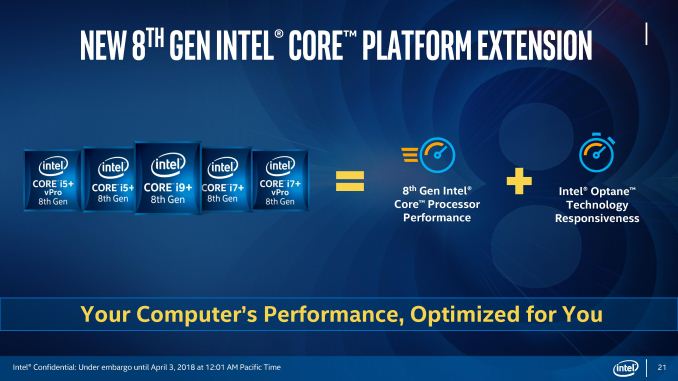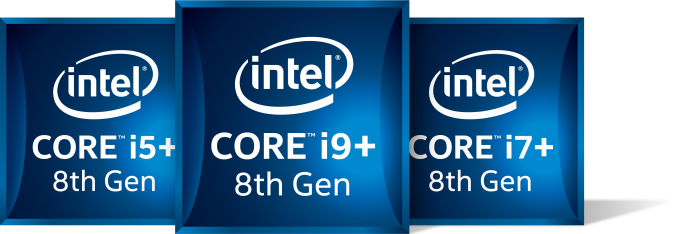Intel Expands 8th Gen Core: Core i9 on Mobile, Iris Plus, Desktop, Chipsets, and vPro
by Ian Cutress on April 3, 2018 3:01 AM ESTNew Optane Branding
Core i9+, Core i7+, Core i5+
One of the items that Intel is keen to promote with this launch is an update to its Intel RST algorithm when dealing with ‘Optane Memory’, Intel’s brand for Optane whereby a small amount of storage is placed in front of a larger drive to act as a fast cache. Up to this point, Intel platforms that supported Optane Memory in this configuration could only do so on the drive that was used to boot into the operating system. While this worked well for low-cost users that relied on a single rotational hard-disk drive of rust for their needs, with most enthusiasts using a fast SSD (SATA or PCIe) as their first drive that loads the OS, putting Optane Memory in front of this as a cache was relatively pointless – any gains would be intangible at best. With the new generation of products, Intel has expanded the capabilities of Optane Memory such that it can act as a cache for a non-OS drive. This means that a user can have a fast SSD boot drive, a large spinning drive for storage, and then place Optane in front of that storage drive to potentially get much better performance from the drive.
The main idea here is that the large rotational drive is where users store games and large files used in content creation, which often have a long loading time. With the right caching algorithm, and a decent sized Optane Memory drive, Intel likes to promote that loading games and loading media for creative purposes are several factors faster than an equivalent system without an Optane Memory drive.
Part of the news around Optane is that Intel is now creating new processor branding for OEMs that have configurations with Optane. The new brands and logos are similar to the standard Core i5/i7 style that we are used to, however the logos are now a dark blue with white text, and exhibit a plus after the Core i5/i7 name.
So just to be clear, this is not a new line of processors. We will not have to suddenly deal with a Core i9+-8950HK being different to the non-plus counterpart. This is purely a branding exercise, and one that only covers the i5 and higher at that. However, to complicate things, this means that specification sheets can (and will) list the processors as Core i5+ and Core i7+ and even vPro models. This makes looking for particular processor versions in search engines a lot more difficult for almost no obvious benefit. I mean sure, Intel wants to promote the use of its Optane drives, but we already have the Optane branding and the Optane logos to do that for us. This ends up being another logo put onto the box.
Ultimately, Intel is still marketing Optane, its high-cost R&D product, with low capacities at low cost systems with relatively little margin. While it might seem like a noble goal, to bring extra caching performance down to the lower cost segment, it could very easily be done with SATA or PCIe M.2 drives using regular NAND flash. A lot of users would like to see high-capacity, high-endurance Optane drives moving more into the mainstream, instead of more attempts at funneling in a product like Optane into caching.













123 Comments
View All Comments
milkywayer - Tuesday, April 3, 2018 - link
Disappointed to see no major desktop cpu releases. I want the next i7 in my workstation SFF. That along with the stuck-in-production GHOST S1 Or Dan Case A4 sff cases.WinterCharm - Tuesday, April 3, 2018 - link
Desktop will come much later... Intel always does this.Y and U series chips >> Mobile chips >> desktop chips.
DanNeely - Tuesday, April 3, 2018 - link
Are you reading the same article I am?Page 4 has 20 (assuming I counted right) additional desktop parts as Intel's filled out the lineup started with a handful of mostly high end K parts last fall.
HStewart - Tuesday, April 3, 2018 - link
I know desktop gamers will not like to hear this - but reality is the desktop market is shrinking and mobile market is where both where the money is at and is increasing performance so desktop market will go away one day.Ratman6161 - Tuesday, April 3, 2018 - link
There are a lot of us out here who actually do work on desktop PC's. Don't forget that gaming is not the only usage. There is no laptop that is going to replace my three 24 inch monitors :)rahvin - Tuesday, April 3, 2018 - link
I have a laptop with 3 independent screens, if I opened the laptop I would have 4 screens. The number of screens has nothing to do with desktop/laptop.FunBunny2 - Tuesday, April 3, 2018 - link
"The number of screens has nothing to do with desktop/laptop."it's the keyboard that is most different.
PeachNCream - Tuesday, April 3, 2018 - link
USB ports.kaidenshi - Tuesday, April 3, 2018 - link
And at that point, why not just have a desktop PC? If it's a desk space issue, UCFF and SFF PCs can now rival full desktop performance. I guess there's the portability angle, you can take your "desktop" with you when you travel and work/game on the road. Otherwise, three large desktop monitors and USB or Bluetooth connected peripherals can be served equally well from a tower, UCFF PC, or a laptop.Galid - Wednesday, April 4, 2018 - link
Can you open your desktop while on a plane, at the hotel, etc... You really want to carry monitor + keyboard + wires +++ while travelling? Facts are there, desktop market is shrinking and laptops are now almost as powerful as a desktop for a couple hundred dollars more. Whatever is the reason behind that, it is happening. I personally own both. Laptop to game at work and desktop to work at home.